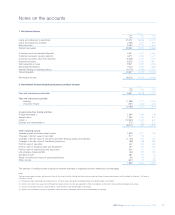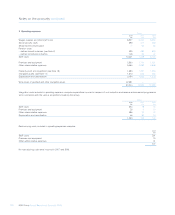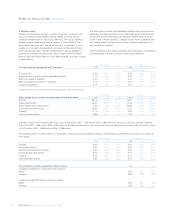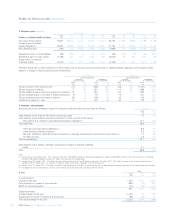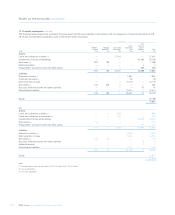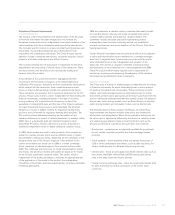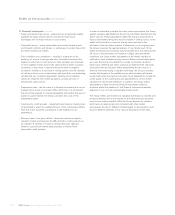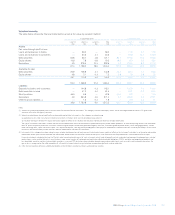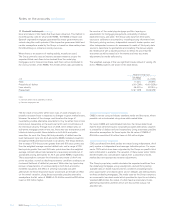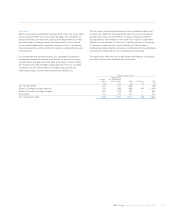RBS 2008 Annual Report Download - page 200
Download and view the complete annual report
Please find page 200 of the 2008 RBS annual report below. You can navigate through the pages in the report by either clicking on the pages listed below, or by using the keyword search tool below to find specific information within the annual report.
199RBS Group Annual Report and Accounts 2008
Valuation of financial instruments
Control environment
The Group’s control environment for the determination of the fair value
of financial instruments has been designed to ensure there are
formalised review protocols for independent review and validation of fair
values separate from those businesses entering into the transactions.
This includes specific controls to ensure consistent pricing policies and
procedures, incorporating disciplined price verification for both
proprietary and counterparty risk trades. The Group ensures special
attention is given to bespoke transactions, structured products, illiquid
products, and other assets which are difficult to price.
The business entering into the transaction is responsible for the initial
determination and recording of the fair value of the transaction. There
are daily controls over the profit or loss recorded by trading and
treasury front office traders.
A key element of the control environment, segregated from the
recording of the transaction’s valuation, is the independent price
verification (IPV) process. Valuations are first calculated by the business
which entered into the transaction. Such valuations may be direct
prices, or may be derived using a model and variable model inputs.
These valuations are reviewed, and if necessary amended, by the IPV
process. This process involves a team, independent of those trading the
financial instruments, reviewing valuations in the light of available
pricing evidence. IPV is performed at a frequency to match the
availability of independent data, and the size of the Group’s exposure.
For liquid instruments the process is performed daily. The minimum
frequency of review in GBM is monthly for regulatory trading book
positions, and six monthly for regulatory banking book positions. The
IPV control includes formalised reporting and escalation of any
valuation differences in breach of defined thresholds. In addition, within
GBM, there is a dedicated team (the Global Pricing Unit) which
determines IPV policy, monitors adherence to policy, and performs
additional independent review on highly subjective valuation issues.
In GBM, when models are used to value products, those models are
subject to a review process which requires different levels of model
documentation, testing and review, depending on the complexity of the
model and the size of the Group’s exposure. A key element of the
control environment over model use in GBM is a review committee
which comprises of valuations experts from several functions within
GBM. The committee sets the policy for model documentation, testing
and review, and prioritises models with significant exposure for review
by the Group’s quantitative research centre. This centre, which is
independent of the trading businesses, assesses the appropriateness
of the application of the model to the product, the mathematical
robustness of the model, and (where appropriate), considers alternative
modelling approaches.
GBM also maintains a valuation control committee that meets formally
on a monthly basis to discuss and review escalated items and to
consider highly complex and subjective valuation matters. The
committee includes valuation specialists representing several
independent review functions (including market risk, quantitative
research and finance) and senior members of the Group’s front office
trading businesses.
Certain financial instruments have become more difficult and subjective
to value and have therefore been transferred to a centrally managed
asset unit, to separate them from business as usual activities and to
allow dedicated focus on the management and valuation of the
exposures. The unit has a valuation committee comprising senior
representatives of the trading function, risk management and GBM
Global Pricing Unit which meets regularly and is responsible for
monitoring, assessing and enhancing the adequacy of the valuation
techniques being adopted for these instruments.
Valuation techniques
The Group uses a number of methodologies to determine the fair values
of financial instruments for which observable prices in active markets
for identical instruments are not available. These techniques include:
relative value methodologies based on observable prices for similar
instruments; present value approaches where future cash flows from the
asset or liability are estimated and then discounted using a risk-adjusted
interest rate; option pricing models (such as Black-Scholes or binomial
option pricing models) and simulation models such as Monte-Carlo.
The principal inputs to these valuation techniques are listed below.
Values between and beyond available data points are obtained by
interpolation and extrapolation. When utilising valuation techniques, the
fair value can be significantly affected by the choice of valuation model
and underlying assumptions made concerning factors such as the
amounts and timing of cash flows, discount rates and credit risk.
•Bond prices – quoted prices are generally available for government
bonds, certain corporate securities and some mortgage-related
products.
•Credit spreads – where available, these are derived from prices of
CDS or other credit based instruments, such as debt securities. For
others, credit spreads are obtained from pricing services.
•Interest rates – these are principally benchmark interest rates such as
the London Inter-Bank Offered Rate (LIBOR) and quoted interest
rates in the swap, bond and futures markets.
•Foreign currency exchange rates – there are observable markets both
for spot and forward contracts and futures in the world’s major
currencies.


